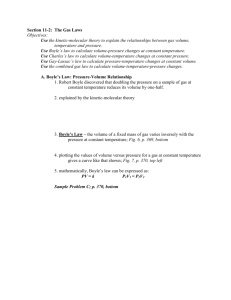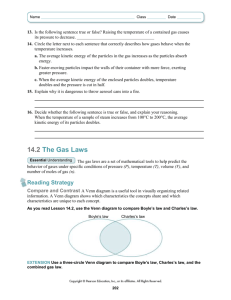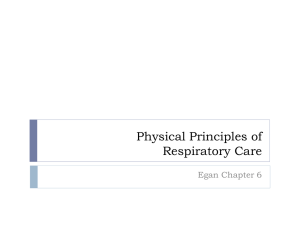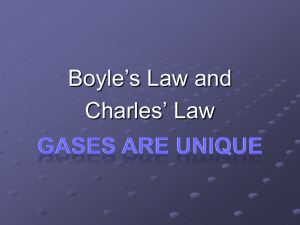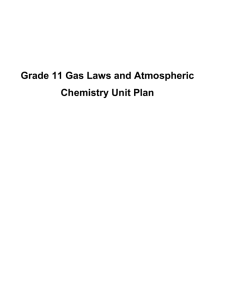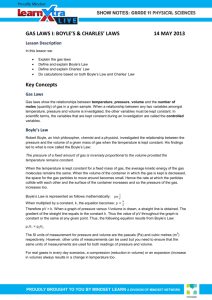gas laws CP - Joy McCourt
advertisement
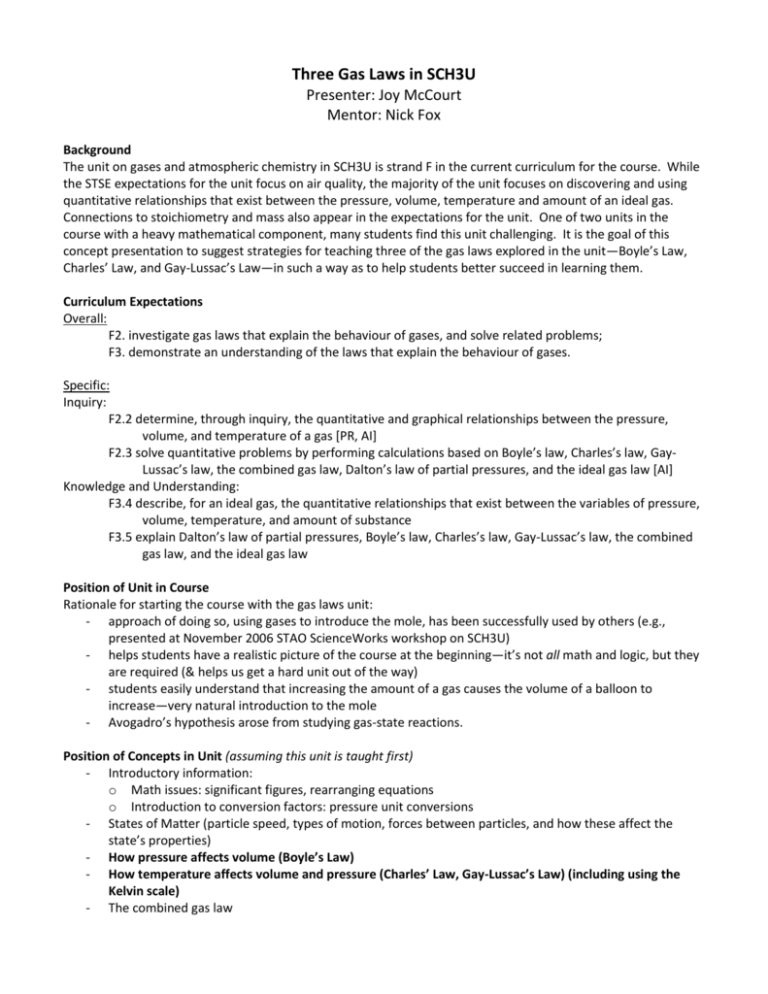
Three Gas Laws in SCH3U Presenter: Joy McCourt Mentor: Nick Fox Background The unit on gases and atmospheric chemistry in SCH3U is strand F in the current curriculum for the course. While the STSE expectations for the unit focus on air quality, the majority of the unit focuses on discovering and using quantitative relationships that exist between the pressure, volume, temperature and amount of an ideal gas. Connections to stoichiometry and mass also appear in the expectations for the unit. One of two units in the course with a heavy mathematical component, many students find this unit challenging. It is the goal of this concept presentation to suggest strategies for teaching three of the gas laws explored in the unit—Boyle’s Law, Charles’ Law, and Gay-Lussac’s Law—in such a way as to help students better succeed in learning them. Curriculum Expectations Overall: F2. investigate gas laws that explain the behaviour of gases, and solve related problems; F3. demonstrate an understanding of the laws that explain the behaviour of gases. Specific: Inquiry: F2.2 determine, through inquiry, the quantitative and graphical relationships between the pressure, volume, and temperature of a gas [PR, AI] F2.3 solve quantitative problems by performing calculations based on Boyle’s law, Charles’s law, GayLussac’s law, the combined gas law, Dalton’s law of partial pressures, and the ideal gas law [AI] Knowledge and Understanding: F3.4 describe, for an ideal gas, the quantitative relationships that exist between the variables of pressure, volume, temperature, and amount of substance F3.5 explain Dalton’s law of partial pressures, Boyle’s law, Charles’s law, Gay-Lussac’s law, the combined gas law, and the ideal gas law Position of Unit in Course Rationale for starting the course with the gas laws unit: - approach of doing so, using gases to introduce the mole, has been successfully used by others (e.g., presented at November 2006 STAO ScienceWorks workshop on SCH3U) - helps students have a realistic picture of the course at the beginning—it’s not all math and logic, but they are required (& helps us get a hard unit out of the way) - students easily understand that increasing the amount of a gas causes the volume of a balloon to increase—very natural introduction to the mole - Avogadro’s hypothesis arose from studying gas-state reactions. Position of Concepts in Unit (assuming this unit is taught first) - Introductory information: o Math issues: significant figures, rearranging equations o Introduction to conversion factors: pressure unit conversions - States of Matter (particle speed, types of motion, forces between particles, and how these affect the state’s properties) - How pressure affects volume (Boyle’s Law) - How temperature affects volume and pressure (Charles’ Law, Gay-Lussac’s Law) (including using the Kelvin scale) - The combined gas law - - Pressure when multiple gases are involved (Dalton’s Law--the hardest one for my students!), including composition of the atmosphere (note: some texts do this law later) How the amount of gas affects volume, pressure, and therefore temperature (the ideal gas law, including an introduction to the concept of the mole; molar volume) Connections to the mass of a gas (including molar mass and using “The Mole Highway” or “The Y Diagram” to convert between mass and volume)—including “The SCH3U Lighter Lab”! (see posted Best Practice) Address the expectation dealing with stoichiometry within the unit on quantities in chemical reactions. Hands-On Possibilities Qualitative Play Time! Give students some simple activities to work through in a guided way, and have them come up with explanations / simple relationships between the variables involved. These activities help students associate the concepts with qualitative, real-world visuals that can help them understand other applications of the laws. Examples: - Using a film canister or balloon to explore Boyle’s Law (increasing pressure decreases volume, until the container can no longer withstand the pressure) - Rinsing a pop bottle with hot water, then sealing it and using it to discuss Charles’ Law - Using the warning label of an appropriately-labeled can of some compressed product (shaving cream, etc.) to discuss (not demonstrate!) Gay-Lussac’s Law (heating a sealed, rigid container of gas causes the pressure inside to increase, until the container can no longer withstand the pressure) Quantitative - 2001 course text by McGraw-Hill Ryerson includes: o using a C-clamp and a sealed plastic pipette to examine Boyles’ Law o gradually heating a sealed plastic pipette to examine Charles’ Law; Rockley and Rockley (1995) give a similar, but more advanced, method - Vernier probeware: Boyle’s Law lab - Purchase various sets of apparatus available on the market o kits by John Eix and Irwin Talesnick (the latter of “Idea Bank” fame) (http://www.s17science.com/) o kit for overhead use available from Nova Scientific Online (http://www.nova-so.ca/product/CGL-83404) Societal Applications - Gas cylinder safety (helium tanks, welders’ acetylene and oxygen tanks, etc.) o Compressed Gas Cylinder Training Video - Missile Hazard (http://www.youtube.com/watch?v=pe9gYRXQTTY) o MythBusters (http://www.youtube.com/watch?v=ejEJGNLTo84) - Occupations and situations that use compressed gases: anesthesia, welding, water treatment… - Popcorn, and some aspects of rising dough - Hot air ballooning - “The bends” (diving) Safety The main safety concerns when studying this unit have to do with: - Pressurized gases - High temperatures Electrical safety when using hot plates and probes - Fire concerns when using Bunsen burners (e.g., to seal plastic pipettes) - Fumes created while sealing plastic pipettes Taking care not to break thermometers Misconceptions and Student Difficulties Difficulty: Gay-Lussac’s Law…or rather, getting past its name. Solutions: - Model what it looks like to discuss the law without being tripped up by its name. If discomfort arises among students, make sensitive use of this “teachable moment.” - Are you using the 2002 Nelson textbook? It actually refers to the law as “the pressure-temperature law,” using the rationale that “history of science references say that Charles, Dalton and Gay-Lussac were all involved in investigating this relationship, with Charles and Dalton doing their work before Gay-Lussac” (p. 435). This approach could be considered for very immature classes (at the cost of some science history and an opportunity for dialogue). Difficulty: figuring out what law is at work / what kind of change is taking place From Horton (2007): “For example, Herbert Beall (1994) lectured college freshmen on the second law of thermodynamics and the ideal gas laws. After the lecture only 11% were able to correctly predict the effect that opening a cylinder of compressed gas would have on the temperature of the gas.” Solutions: - Include qualitative hands-on examples to give the students “hooks” on which to hang the concepts and relate to new situations. - Teach students to examine units and descriptions provided for clues. Practice this as a class. - Use the GRASP method mentioned in previous presentations: What are you given? What are you asked to find? Which equation relates those quantities? Difficulty: visualizing what’s going on at the molecular level Solutions: - put it in real-world terms. Jumpy, energetic dancers dancing to fast-paced music collide more often and put a lot more pressure on the dance floor than dancers doing a slow dance. (They’re probably also warmer!) The molecules of a gas move around more at a high temperature and collide with the container more often, leading to higher pressure. - use a simulator (either as a demo or as a worksheet-guided computer lab activity) o http://www.chem.ufl.edu/~itl/2045/MH_sims/gas_sim.html is visually appealing and can be used to illustrate the effect of changing n as well, but cannot be used for Charles’ Law o http://intro.chem.okstate.edu/1314f00/laboratory/glp.htm is useful, but bare-bones Difficulty: rearranging equations - May know how to rearrange in addition/subtraction examples (x + 5 = 7), but inappropriately try to add/subtract when multiplying or dividing are required May have always struggled with solving equations in their math courses, and can only solve for x in the previous example by using guess-and-check. Solution: - Not quickly dealt with, so have patience. - Help students understand what is going on in the equation as is…“PV” means the P is multiplying the V. If I only want V, I must undo that multiplication by dividing both sides of the equation by P. - Go back to easier mathematical examples: how can you solve for x if 3x = 12? - See if the student’s math teachers can offer insight. Challenging/Supporting Different Levels of Classes Ready for a Challenge - Take them through the full work-up of each law, including the use of proportionality constants - Embed less scaffolding / fewer supports in questions - Expect more detailed explanations of the situation at the microscopic level - Expect them to explain why all three variables are actually involved in a given situation Need More Support - Help them to see the connection between what we expect in the real world and the form of the relevant equation; set up ratios as you rearrange the equations - Embed more scaffolding and support into questions; teach students to work carefully through calculations by using GRASP or a similar strategy - Teach them to make a common-sense prediction first, then check their calculated answer against their prediction - Fewer questions / extra time. Supporting Different Kinds of Learners Visual style/Spatial intelligence: may find the microscopic picture easier to grasp than other students again, check the reasonableness of answers by considering the real-world picture Linguistic intelligence: Reading style: assigned to consolidate inclass learning Writing style: summarizing (in writing) those readings and their hands-on work and writing notes/filling in blanks during lectures Auditory style: may prefer to spend more time listening to and taking in the lecture than on taking notes Verbal: may benefit from “talking through” practice problems with a partner or the teacher. Interpersonal learners may also benefit from “talking through” practice problems. Kinesthetic learners will benefit the most from hands-on learning approaches already mentioned. Naturalistic learners may find concepts easier to grasp by connecting them to everyday occurrences, such as the popping of popcorn and breathing Logical-mathematical students will likely find the calculations easier than their classmates; if they lack a Visual style, the simulations may help them until they can make a logical connection to what’s going on in the situation. Musical: Later in the unit: for 99 cents, you can download Professor Boggs’ “Hey, Avogadro” about the ideal gas law: http://www.songsforteaching.com/science/ professorboggs/avogadrosnumber.htm Challenge all students to use what works for them when trying to remember the laws, such as by making up a song (but they can only sing it in their heads during quizzes ). At least one teacher makes this an assignment: see one example of student product at http://www.youtube.com/watch?v=Hbb9dG mU0r0 Intrapersonal intelligence…how can these learners best be supported, other than by allowing them to work independently (a strategy that doesn’t actually connect to self-knowledge)? Suggested Lesson Sequence: Description of Activity Day 1 – Exploring Qualitative Relationships “Play Time”: Groups work on activities leading to qualitative development of pressurevolume-temperature relationships Consolidation: groups report findings back to class Chalk-and-talk with use of simulations, pictures and real-world analogies: what is going on at the microscopic level? Use Boyle’s Law apparatus to draw out quantitative patterns in the relationship between pressure and volume Day 2 – Using Boyle’s Law Chalk-and-talk: Boyle’s Law, and using PredictGRASP-Check to solve Boyle’s Law problems Students work on a few practice problems alone or in pairs Demonstrate procedure for Charles’ Law lab students will perform next day Day 3 – Charles’ Law lab Students complete a lab in pairs introducing them to Charles’ law, absolute zero and the importance of the Kelvin scale If desired and time permits, schedule time in a computer lab for analysis and graphing of data in Excel Teaching/Learning Strategies Expectations Addressed Learning Styles and Intelligences Assessment Guided inquiry F3.5 F3.4 Student as instructor Direct instruction Technology Demonstration Direct instruction Collaborative problemsolving Demonstration Guided inquiry Technology (option) Interpersonal Kinesthetic Visual Verbal Auditory Logicalmathematical F2.3 F3.4 F3.5 F2.2 F3.4 Logicalmathematical Auditory Writing (fill in handout) Interpersonal Intrapersonal Kinesthetic Interpersonal Visual Logicalmathematical Verbal reports from each group Exit pass: “Will the _____ increase or decrease?” for 2 different situations (qualitative only!) During examples, diagnose students’ ability to rearrange equations Clarifications sought by students; common errors / wrong answers Collect lab sheets for assessment of data analysis and discussion questions Day 4 –Charles’ & Gay-Lussac’s Laws; Putting it All Together Consolidate students’ lab results Chalk-and-talk: Charles’ Law (and, after demonstration, Gay-Lussac’s Law), the Kelvin scale, and using Predict-GRASP-Check to solve If available, use apparatus designed to demonstrate Gay-Lussac’s Law Groups work on problems which can be solved using the three gas laws studied, using GRASP to identify the appropriate law and solve; groups then present their solution process Day 5 Evaluate understanding of and ability to use gas laws studied to date Socratic discussion Direct instruction F3.4 F2.3 F3.5 Demonstration Collaborative problemsolving F2 F3 Verbal Auditory Logicalmathematical Writing (fill in handout) Visual Students’ ability to verbalize relationship discovered Students’ ability to rearrange these equations (more difficult than Boyle’s Law) Students’ ability to identify an appropriate law to solve a problem Evaluation: quiz on Boyle’s, Charles’ and GayLussac’s laws Continue with strategies to teach the combined gas law and other concepts in the course. References (also see above for links to apparatus suppliers, videos, and online simulations) - Ontario Science curriculum (2008 revision) (The guideline for all we do) - Horton, C. (2004). Student Misconceptions and Preconceptions in Chemistry. California Journal of Science Education, 7 (2), 1531-2488. (Used in research of student misconceptions) - Jenkins, Frank, et al. (2002). Chemistry 11. Toronto: Nelson. (Course text for previous curriculum) - Mustoe, Frank, et al. (2001). Chemistry 11. Toronto: McGraw-Hill Ryerson. (Course text for previous curriculum) - Rockley, Natalie L. (1995). A Charles’ Law Experiment for Beginning Students. Journal of Chemical Education, 72 (2), 179-181 (As noted above, this article outlines a way of performing a Charles’ Law experiment with more sophisticated equipment, including a discussion of a reasonable error range to expect) - STAO ScienceWorks SCH3U workshop (November 2006) (Presenter suggested approach of teaching the gas laws unit as the first unit in the course)

